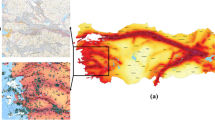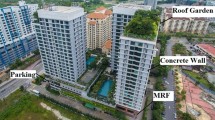Abstract
Adding concrete walls by infilling certain frame bays with reinforced concrete is popular for seismic retrofitting, but is covered by codes only if the connection of the old concrete to the new ensures monolithic behavior. To avoid penalizing the foundation of the new wall with a very high moment resistance, the new concrete should not be thicker than, or surround, the old frame members. A cost-effective connection of these members to a thin new web is proposed, alongside a design procedure and detailing that conform to current codes. Owing to practical difficulties, footings of added walls are often small and weakly connected to the other footings, hence they uplift and rock during the earthquake. The model for uplift of 3D footings consists of two pairs of nonlinear-elastic springs in a cross layout and approximates also moderate nonlinearities in the soil continuum. It is used in nonlinear, static or dynamic, analyses of three buildings with added walls. The analyses of a clean, regular 4-story building show the benefit from uplift to the added walls and a certain adverse effect on some columns but not on beams, as well as the lack of a clear positive effect of tie-beams. The application to a 7-story and a 2-story real building with extreme, yet typical, irregularities in plan and elevation exemplifies the real-life restrictions in the use of added walls and shows their limits for the improvement of seismic performance; certain deficiencies in flexure or shear remain in both and are corrected at very low cost with local fiber reinforced polymer (FRP) jackets without new analysis of the building, as FRPs do not change the member effective stiffness or moment resistance.










Similar content being viewed by others
References
Allotey N, El Naggar MH (2008a) An investigation into the Winkler modeling of the cyclic response of rigid footings. Soil Dyn Earthq Eng 28:44–57
Allotey N, El Naggar MH (2008b) Generalized dynamic Winkler model for nonlinear soil-structure interaction analysis. Can Geotech J 45:560–573
Altin S, Anil O, Kara E (2008) Strengthening of RC nonductile frames with RC infills: an experimental study. Cem Concr Compos 30:612–621
Altin S, Ersoy U, Tankut T (1992) Hysteretic response of reinforced-concrete infilled frames. ASCE J Struct Eng 118(8):2133–2150
Biskinis D, Fardis MN (2010a) Deformations at flexural yielding of members with continuous or lap-spliced bars. Struct Concr 11(3):127–138
Biskinis D, Fardis MN (2010b) Flexure-controlled ultimate deformations of members with continuous or lap-spliced bars. Struct Concr 11(2):93–108
Biskinis D, Roupakias G, Fardis MN (2004) Degradation of shear strength of RC members with inelastic cyclic displacements. ACI Struct J 101(6):773–783
Canbay E, Ersoy U, Ozcebe G (2003) Contribution of reinforced concrete infills to seismic behavior of structural systems. ACI Struct J 100(5):637–643
CEN (2005) EN 1998–3:2005 Eurocode 8: design of structures for earthquake resistance—part 3: assessment and retrofitting of buildings. Comité Européen de Normalisation, Brussels
Chatzigogos CT, Pecker A, Salençon J (2009) Macroelement modeling of shallow foundations. Soil Dyn Earthq Eng 29(5):765–781
Chatzigogos CT, Figini R, Pecker A, Salençon J (2011) A macroelement formulation for shallow foundations on cohesive and frictional soils. Int J Numer Anal Methods Geomech 35(8):902–931
Chopra A, Yim SC (1985) Simplified earthquake analysis of structures with foundation uplift. ASCE J Struct Eng 111(4):906–930
Chrysostomou CZ, Kyriakides N, Kotronis P, Poljanšek M, Taucer F, Roussis P, Kosmopoulos A (2012) Seismic retrofitting of RC frames with RC infilling. In: Proceedings, 15th world Conference on earthquake engineering, Lisbon (Paper 4144)
Crémer C, Pecker A, Davenne L (2001) Cyclic macro-element for soil-structure interaction: material and geometrical nonlinearities. Int J Numer Anal Methods Geomech 25(12):1257–1284
Crémer C, Pecker A, Davenne L (2002) Modelling of nonlinear dynamic behaviour of a shallow strip foundation with macro-element. J Earthq Eng 6(2):175–212
Erdem I, Akyuz U, Ersoy U, Ozcebe G (2006) An experimental study of two different strengthening techniques for RC frames. Eng Struct 28:1843–1851
Fardis MN (2012) Seismic engineering research infrastructures for European synergies (SERIES). In: Proceedings, 15th world conference on earthquake engineering, Lisbon (Paper 3001)
fib (2012) Model Code 2010 - Final draft. Vol. 1: Bulletin 65, Vol. 2: Bulletin 66, fédération internationale du béton ( fib), Lausanne
Gelagoti F, Kourkoulis R, Anastasopoulos I, Gazetas G (2012) Rocking isolation of frames founded on isolated footings. Earthq Eng Struct Dyn 32:87–102
Harden CW, Hutchinson TC (2009) Beam-on-nonlinear-Winkler-foundation modeling of shallow, rocking-dominated footings. Earthq Spectra 25(2):277–300
Higashi Y, Endo T, Shimizu Y (1984) Experimental studies on retrofitting of reinforced concrete building frames. In: Proceedings, 8th world conference on earthquake engineering, San Francisco, pp 477–484
Keintzel E (1990) Seismic design shear forces in RC cantilever shear wall structures. Eur J Earthq Eng 3:7–16
Kosmopoulos A, Fardis MN (2007) Estimation of inelastic seismic deformations in asymmetric multistory RC buildings. Earthq Eng Struct Dyn 36(9):1209–1234
Kosmopoulos A, Fardis MN (2008) Simple models for inelastic seismic analysis of asymmetric multistory buildings. J Earthq Eng 12(5):704–727
Kourkoulis R, Gelagoti F, Anastasopoulos I (2012) Rocking isolation of frames on isolated footings: design insights and Limitations. J Earthq Eng 16(3):374–400
Mori K, Murakami K, Sakashita M, Kono S, Tanaka H (2008) Seismic performance of multistory shear wall with an adjacent frame considering uplift of foundation. In: Proceedings, 14th world conference on earthquake engineering, Beijing
Otani S (1974) Inelastic analysis of R/C frame structures. ASCE J Struct Div 100(ST7):1433–1449
Psycharis I (1983) Dynamics of flexible systems with partial lift-off. Earthq Eng Struct Dyn 12(2):201–521
Qin X, Chouw N (2010) Experimental investigation of uplift effect on structures in earthquakes. In: Proceedings, New Zealand society for earthquake engineering conference, Paper 14
Raychowdhury P (2011) Seismic response of low-rise steel moment-resisting frame buildings incorporating nonlinear soil-structure interaction. Eng Struct 33:958–996
Rejec K, Isakovic T, Fischinger M (2012) Seismic shear force magnification in RC cantilever structural walls designed according to Eurocode 8. Bull Earthq Eng 10(2):567–586
Reynouard JM, Fardis MN (eds) (2001) Shear walls ECOEST/ICONS Report no. 5 LNEC Publications, Lisbon, 240 p
Roeder CW, Banerjee S, Jung DR, Smith SK (1996) The role of building foundations in seismic retrofit. Earthq Spectra 12(4):925–942
Rutenberg A, Nsieri E (2006) The seismic shear demand in ductile cantilever wall systems and the EC8 provisions. Bull Earthq Eng 4(1):1–21
Sonuvar M, Ozcebe G, Ersoy U (2004) Rehabilitation of reinforced concrete frames with reinforced concrete infills. ACI Struct J 101(4):494–500
Strepelias E, Palios X, Bousias SN, Fardis MN (2013) Experimental investigation of concrete frames infilled with RC for seismic rehabilitation. ASCE J Struct Eng 139. doi:10.1061/(ASCE)ST.1943-541X.0000817
Turk M, Ersoy U, Ozcebe G (2003) Retrofitting of reinforced concrete frames with reinforced concrete infill walls. in: Proceedings, fib symposium: concrete structures in seismic regions, Athens
Acknowledgments
This work has received funding from the Research Promotion Foundation (RPF) of Cyprus for Project ASTI/0308(BIE): “Seismic vulnerability and strengthening of existing privately owned buildings” of RPF’s FP 2008.
Author information
Authors and Affiliations
Corresponding author
Rights and permissions
About this article
Cite this article
Fardis, M.N., Schetakis, A. & Strepelias, E. RC buildings retrofitted by converting frame bays into RC walls. Bull Earthquake Eng 11, 1541–1561 (2013). https://doi.org/10.1007/s10518-013-9435-6
Received:
Accepted:
Published:
Issue Date:
DOI: https://doi.org/10.1007/s10518-013-9435-6




